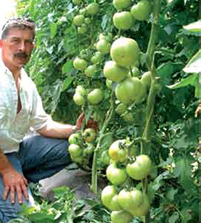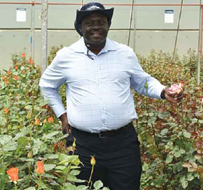Featured Past Articles
Delays at Port Spark Fears of Price Increase and Fertiliser Shortage

The government has directed that fertiliser imports be expeditiously inspected at the port of Mombasa to alleviate shortage that has seen an increase in prices of the crucial farm input.
Public Service Deputy Head and Multi- Agency Taskforce on Enforcement of Standards Chairman Wanyama Musiambo, said every tested consignment that meets Kenya Bureau of Standards (KEBS) requirements be released forthwith. Mr. Musiambo also directed the Kenya Flower Council (KFC) to immediately inform his office of any unnecessary delays to facilitate decisive action against officials frustrating the government’s efforts to rid Kenya of counterfeit and substandard goods.
In an interview, KFC chief executive Mr. Clement Tulezi decried continued delay in releasing approved consignments that were incurring hefty storage charges. “We are the third highest foreign earner after tea and tourism as well as employs the highest number of Kenyans at over 300,000. Denying us access to imported fertiliser is akin to stifling our continued growth,” he said.
Read more: Delays at Port Spark Fears of Price Increase and Fertiliser Shortage

On October 19, the U.S. Food and Drug Administration (FDA) issued two draft guidance documents to help farmers and fresh-cut produce processors better understand what they need to do to meet requirements established by the FDA Food Safety Modernization Act (FSMA).
The first draft guidance is a compliance and implementation guide to assist growers with meeting the requirements of the Produce Safety Rule under FSMA. To further assist farmers and other stakeholders, FDA has also published At-A-Glance overviews that highlight the key points in each chapter in the draft guidance.
The second draft guidance issued today, Guide to Minimize Food Safety Hazards of Fresh-cut Produce, explains the FDA’s current thinking on how fresh-cut produce processors, such as those that prepare bagged salad mixes and fruit salad, may comply with the requirements found in the Preventive Controls for Human Food Rule under FSMA.
 Treasury secretary Henry Rotich’s 2018/2019 budget proposals are like no other since Independence. Although his intentions were to stimulate manufacturing and create jobs, he may have inadvertentlyput himself in a corner where labour unions and the poor will use him as a punching bag.
Treasury secretary Henry Rotich’s 2018/2019 budget proposals are like no other since Independence. Although his intentions were to stimulate manufacturing and create jobs, he may have inadvertentlyput himself in a corner where labour unions and the poor will use him as a punching bag.
Perhaps he needed data to decide what to tax. Not too long ago, Kenyans took to the streets seeking affordable unga (flour) to which the government responded with subsidies. In the past month, farmers in North Rift were on the streets protesting against unknown people who have flooded the local market with cheap foreign maize leaving farmers to suffer with huge inventory.
Corruption allegations at the National Cereals and Produce Board are yet to be resolved. There is no logic in undermining farmers then asking them to tighten their belts and pay tax. They will have no option but to protest in the streets as they have done in the past month.

Salvaging Tomato Production in Kenya from the Menace of Pest and Diseases. The case of– Tuta Absoluta and Fusarium wilt root-knot nematode complex.
Why tomato?
Tomato is one of the most important vegetables grown in Kenya. It plays a critical role in income generation and creation of employment for both rural and urban populations, in addition to meeting food nutritional requirements. Tomato is a nutritious vegetable that provides good quantities of vitamins A and C.
Tomatoes are used in many cooking recipes or as a fresh item in combination with salads. Tomatoes are grown for the domestic market under both rain-fed and irrigated conditions. Due to the high demand for tomato, farmers have extensively adopted high yielding varieties and modern technologies like greenhouse production to ensure year round increased production. Commercial farming of this important crop is however under immense threat from pests and disease, mainly Fusarium wilt, Nematode complex and the Tuta absoluta (tomato leafminer). Some farmers have reported yield losses of up-to 80-100 % per growing season.
Thrips represent probably the number one pest in ornamentals, not only in Kenya but also globally. If we were to ask a Kenya rose grower what was number one pest, ten – fifteen years ago this would have been definitely red spider mite. However, spider mite control has moved on. Now we have predatory mites Phytoseiulus persimilis and Amblysieus californicus, we have biopesticides like Achieve and finally we have the organosilicon physical action sprays. These products have transformed the control of spider mite in Kenya. So where are we with thrips and why is this pest seemingly such an intractable problem.
 Born and brought up in othaya sub county, Nyeri county. Mr. Simon Kihungu completed his Primary and Secondary School education successfully. In 2003, he joined JKUAT where he pursued BSC in horticulture degree course and graduated in 2007 then joined Bayer East Africa Ltd immediately after completing his undergraduate studies. Upon joining Bayer East Africa Ltd, he started as a product promoter in charge of Nyeri, Laikipia East and the central parts of Murang’a. He then moved to Coast as the area sales representative for the region and one year later joined the floriculture sector. He speaks to Floriculture Magazine on his daily challenges
Born and brought up in othaya sub county, Nyeri county. Mr. Simon Kihungu completed his Primary and Secondary School education successfully. In 2003, he joined JKUAT where he pursued BSC in horticulture degree course and graduated in 2007 then joined Bayer East Africa Ltd immediately after completing his undergraduate studies. Upon joining Bayer East Africa Ltd, he started as a product promoter in charge of Nyeri, Laikipia East and the central parts of Murang’a. He then moved to Coast as the area sales representative for the region and one year later joined the floriculture sector. He speaks to Floriculture Magazine on his daily challenges
Briefly discuss the challenges you go through daily? What would you point out as your strongest attribute that has made you succeed?
Just like any other job, there are common challenges that do occur in the line of duty. However, with the support from my company and good relationship and support from my clients, together we succeed.
 What should growers consider before choosing a variety?
What should growers consider before choosing a variety?
When you have paid attention to the market, location, disease susceptibility and vase life have been considered. The following additional actions should be taken by the grower: soil testing, water test, rainfall amount measurement, temperature measurements and consideration of variety trials and data available on a given variety of interest plays a very important role.
Market
Flower business just like any other business starts from the customers’ end; this involves a detailed research by the grower to understand and decide if he/she will grow for premium or retail markets. Premium markets focus on the auctions and high-end florists and their requirements differ from those in retail. For instance, premium markets need a 5cm head size flower and above while retail markets demand 4 cm and above.


